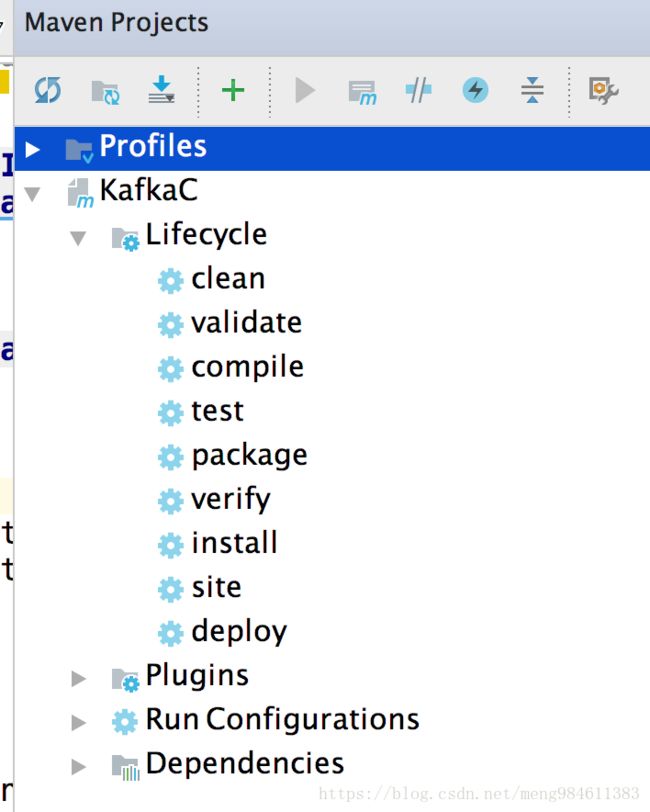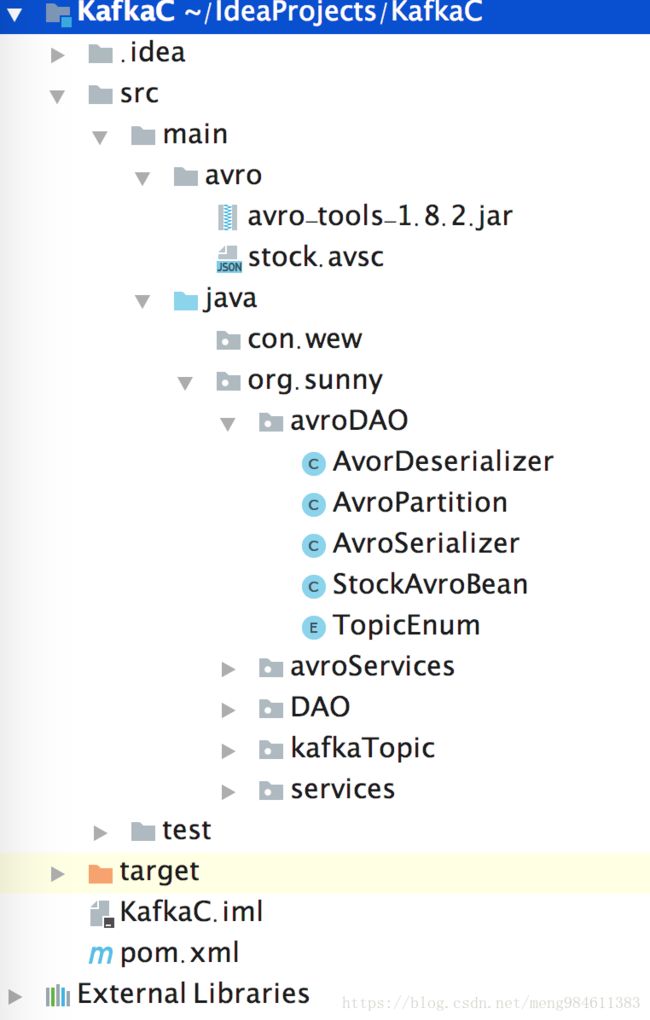利用Avro实现Kakfa序列化和反序列化
1 在pom.xml中添加依赖,
1.1 在dependencies中配置:
org.apache.avro
avro
1.8.2
org.apache.avro
avro-tools
1.8.2
org.apache.avro
avro-maven-plugin
1.8.2
org.apache.avro
avro-compiler
1.8.2
1.2 在
org.apache.avro
avro-maven-plugin
1.8.2
generate-sources
schema
${project.basedir}/src/main/avro/
${project.basedir}/src/main/java/
org.apache.maven.plugins
maven-compiler-plugin
1.8
1.8
2 定义avro的scheme
2.1 Avro scheme是通过JSON形式来定义的,一般以.avsc结尾(maven插件会去指定目录下获取.avsc结尾的文件并生成成java文件)。
stock.avsc内容如下:
namespace —— 生成的java文件的包
type —— record
name —— 生成类的名字
fields —— 字段名和类型
{
"namespace":"org.sunny.avroDAO",
"type":"record",
"name":"StockAvroBean",
"fields":[
{"name":"stockCode","type":"string"},
{"name":"stockName","type":"string"},
{"name":"tradeTime","type":"long"},
{"name":"preclosePrice","type":"float"},
{"name":"openPrice","type":"float"},
{"name":"currentPrice","type":"float"}
]
}2.2 利用*.avsc文件生成.java文件,IDEA->Tool Window->Maven Projects-> compile或者install都可以,在namespace的包下生成name.java文件(StockAvroBean.java)。
StockAvroBean.java是org.apache.avro.specific.SpecificRecordBase的子类。
另外,avro提供了一个avro-tools包来生成java文件,可以通过下面命令:
java -jar /path/to/avro-tools-1.8.0.jar compile schema 这也是为什么没有avro/avro-tools-1.8.2.jar出现在avro文件夹中的原因。
3 实现序列化.class、反序列化.class,同时,为了方便起见,定义TopicEnum枚举类实现topic和value的class之间的映射。
3.1 序列化:
import org.apache.avro.io.BinaryEncoder;
import org.apache.avro.io.DatumWriter;
import org.apache.avro.io.EncoderFactory;
import org.apache.avro.specific.SpecificDatumWriter;
import org.apache.avro.specific.SpecificRecordBase;
import org.apache.kafka.common.serialization.Serializer;
import java.io.ByteArrayOutputStream;
import java.io.IOException;
import java.util.Map;
/**
* 序列化
* @param
*/
public class AvroSerializer implements Serializer {
@Override
public void configure(Map map, boolean b) {}
@Override
public byte[] serialize(String topic, T data) {
if (data == null){
return null;
}
DatumWriter writer = new SpecificDatumWriter<>(data.getSchema()); //将data的schema装进去
ByteArrayOutputStream outputStream = new ByteArrayOutputStream();
BinaryEncoder encoder = EncoderFactory.get().directBinaryEncoder(outputStream,null);
try {
writer.write(data,encoder);
}catch (IOException e){
e.printStackTrace();
}
return outputStream.toByteArray();
}
@Override
public void close() {}
}
3.2 反序列化:
import org.apache.avro.io.*;
import org.apache.avro.specific.SpecificDatumReader;
import org.apache.avro.specific.SpecificRecordBase;
import org.apache.kafka.common.serialization.Deserializer;
import java.io.ByteArrayInputStream;
import java.io.IOException;
import java.util.Map;
/**
* 反序列化
*/
public class AvorDeserializer implements Deserializer {
@Override
public void configure(Map map, boolean b) {}
@Override
public T deserialize(String topic, byte[] data) {
if (data == null){
return null;
}
try {
//得到主题对应的数据类型
TopicEnum topicEnum = TopicEnum.getTopicEnum(topic);
if (topicEnum == null){
return null;
}
SpecificRecordBase record = topicEnum.getRecord();
DatumReader datumReader = new SpecificDatumReader<>(record.getSchema());
ByteArrayInputStream byteArrayInputStream = new ByteArrayInputStream(data);
BinaryDecoder decoder = DecoderFactory.get().directBinaryDecoder(byteArrayInputStream,null);
return datumReader.read(null,decoder);
}catch (IOException e){
e.printStackTrace();
}
return null;
}
@Override
public void close() {}
}
3.3 TopicEnum:将topic和value对应的class文件进行关联:
import org.apache.avro.specific.SpecificRecordBase;
import org.apache.commons.lang.StringUtils;
/**
* 将topic和value对应的类对应起来
*/
public enum TopicEnum {
STOCK_AVOR("avro-kafka",new StockAvroBean()); //实例
private String topic;
private SpecificRecordBase record;
private TopicEnum(String topic,SpecificRecordBase record){
this.topic = topic;
this.record = record;
}
...Getter and Setter...
public static TopicEnum getTopicEnum(String topicName){
if (topicName.isEmpty()){
return null;
}
for (TopicEnum topicEnum : values()){
if (StringUtils.equalsIgnoreCase(topicEnum.getTopic(),topicName)){
return topicEnum;
}
}
return null;
}
}
4 在Producer和Consumer中配置属性
消费者的配置部分:
public class AvroConsumer {
private static final String BOOTSTRAP_SERVER = "LOCALHOST:9092";
private Properties initConfig(){
Properties config = new Properties();
config.put(ConsumerConfig.BOOTSTRAP_SERVERS_CONFIG,BOOTSTRAP_SERVER);
config.put(ConsumerConfig.ENABLE_AUTO_COMMIT_CONFIG,false);
config.put(ConsumerConfig.GROUP_ID_CONFIG,"avro-group");
config.put(ConsumerConfig.KEY_DESERIALIZER_CLASS_CONFIG, StringDeserializer.class.getName());
config.put(ConsumerConfig.VALUE_DESERIALIZER_CLASS_CONFIG, AvorDeserializer.class.getName());
return config;
}
}
生产者的配置部分:
public class AvroProducer {
private static final String BROKER_LIST = "localhost:9092";
public AvroProducer(String[] topics){
this.topics = topics;
}
private static Properties initconfig(){
Properties config = new Properties();
config.put(ProducerConfig.BOOTSTRAP_SERVERS_CONFIG,BROKER_LIST);//broker_list
config.put(ProducerConfig.KEY_SERIALIZER_CLASS_CONFIG, StringSerializer.class.getName());
config.put(ProducerConfig.VALUE_SERIALIZER_CLASS_CONFIG, AvroSerializer.class.getName());
config.put(ProducerConfig.PARTITIONER_CLASS_CONFIG,AvroPartition.class.getName()); //自定义的分区准则
return config;
}
}题外话,上面自定义的分区准则,是通过继承org.apache.kafka.client.producer.Partition实现的,下面提供一种实现方法:
import org.apache.kafka.clients.producer.Partitioner;
import org.apache.kafka.common.Cluster;
import java.util.Map;
/**
* 实现自己的分区逻辑
*/
public class AvroPartition implements Partitioner {
@Override
public int partition(String topic, Object key, byte[] keybytes, Object value, byte[] valuebytes, Cluster cluster) {
if (key==null){
return 0;
}
String partitionKey = key.toString();
try {
//根据key的最后一位和partitions取模,设置分区
int partitionID = Integer.valueOf(partitionKey.substring(partitionKey.length()-2)) % 6;
System.out.println(partitionID);
return partitionID;
}catch (Exception e){
e.printStackTrace();
}
return 0;
}
@Override
public void close() {}
@Override
public void configure(Map map) {}
}
参考文章:
Avro序列化操作(1):环境搭建和Schema处理
Apache Avro 1.8.1 入门指南(Java)
Apache Avro
Avro与Java


